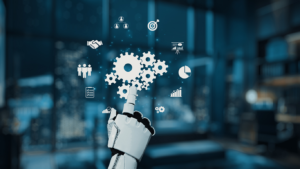As far as we can remember, businesses have been trying to get the upper hand in defending themselves against cyber attacks. And for a while, it seemed like they were fighting a losing battle. As a matter of fact, a 2018 report revealed that cyber attacks were so common that they happened every 39 seconds, affecting one in every three Americans annually.
However, things seem to have taken a different trajectory since businesses started incorporating AI in their cybersecurity measures. Apart from now being a household term, AI has infiltrated various industries with its efficiency, speed, and accuracy. It’s those very attributes that have helped cyber experts craft ingenious ways in which AI can help in the fight against cyber attacks. So, how does AI help boost cybersecurity in businesses?
Providing Vulnerability Assessment Reports
AI has been a game-changer when it comes to matters of vulnerability management. In the past, this critical aspect of cyber security heavily relied on manual processes. Those processes often struggled to keep cyber attacks at bay, especially concerning accuracy, speed, and scalability.
But here comes AI-powered solutions. These proactive yet automated solutions reshaped how businesses detected, evaluated, and responded to vulnerabilities. And to make things better, it performed these functions continuously in real-time.
From predictive analysis through machine learning to the automation of faster risk detection to risk prioritization, AI has helped drastically reduce the window of exposure to high-risk vulnerabilities.
Eliminates Time-Consuming Tasks
Business owners have a lot on their plate, even without including cybersecurity measures. Thus, AI-powered cybersecurity solutions seek to handle those mundane cybersecurity tasks, leaving them to focus on more critical business areas.
But how does it do this? Well, first, AI processes vast chunks of data. In fact, it can do this and detect threats faster than any human expert could. What’s more, it can correlate patterns based on previous happenings and insights, hence helping to prevent cyber attacks proactively.
Not to forget that these solutions are easily scalable. That way, there’s no need for significant expert or hardware costs when you want to increase protection for your business data and processes.
Quicker in Detecting Malware Threats
To keep your data safe, you always have to stay ahead of cybercriminals. But that’s easier said than done, especially since they manage to re-invent their mode of attack ever so frequently.
However, America, the top dog when it comes to global cybersecurity index (GCI) rankings, through the help of various federal organizations, has laid out guidelines and strict legislation to help businesses safeguard their data and processes. That includes the use of AI in malware threat detection and analysis.
AI’s intrinsic ability to process huge amounts of data makes it relatively easy to identify irregular patterns. Likewise, through machine learning technology and logical inference gained from its access to vast amounts of data, this technology can process data and notice even the most innovative security breaches.
As such, businesses that process vast amounts of customer data, like American online casinos, have already leveraged AI-powered cybersecurity solutions as a proactive approach to their data privacy measures. After all, with players submitting a massive chunk of their personal and financial data to such businesses when creating accounts, it’s not a surprise that they are among the top targets for cybercriminals.
The Risk of Using AI in Cybersecurity
Over the years, AI has proven efficient in analyzing large data sets, detecting cyber threats early, and even managing vulnerabilities. But cybercriminals are also aware of this dynamic force and are leveraging it for malicious purposes. With AI tools becoming more accessible, AI increasingly continues to threaten proactive cybersecurity solutions.
A common risk of AI to cybersecurity is the optimization of cyber attacks. According to several cybersecurity experts, the increased adoption of large language models (LLMs) paired with generative AI can lead to scalable cyber attacks of unseen accuracy and complexity.
An excellent example of this is using generative AI to optimize phishing and ransomware attacks or even finding algorithms to guess passwords correctly. Cybercriminals may also take advantage of geopolitical tensions to undermine cloud complexities, enabling them to launch advanced attacks.
In light of these risks, experts recommend not entirely relying on AI-powered cybersecurity solutions. After all, everything on this earth has a flaw, even the most powerful and transformative force that is AI.
To prevent landing on the wrong end of such innovations, we recommend that you regularly audit your AI systems, limit the automated sharing of sensitive information with these systems, and constantly check as well as install the latest software updates and security patches.
Amp Up Your Cybersecurity Solutions with AI
Cybersecurity systems should always be vigilant and agile, especially in this modern era of AI. While AI-powered cyber solutions have been crucial in the fight against malicious attacks, businesses still need to be wary of these systems. After all, you don’t want to implement a solution that will just give you away to the enemy, right?
That’s why businesses should consider several factors before choosing an AI-powered cyber product. These include:
- The data you intend to use to train your AI model
- Hardware and other computational requirements your AI solution requires
- Privacy and security policy of the system
- Ethical implication of the software
- How the system will integrate with your existing processes, etc.
But, above all else, ensure that you combine the human factor with your AI system. Nowadays, it’s no longer enough to have one approach to cybersecurity. However, by implementing AI cyber solutions alongside training your employees on leveraging AI features, your business will be well-equipped to stay secure in the ever-changing digital world.




